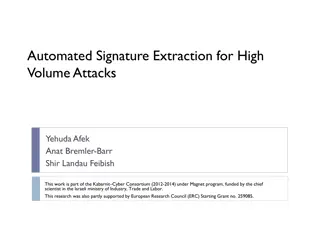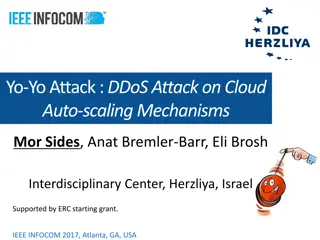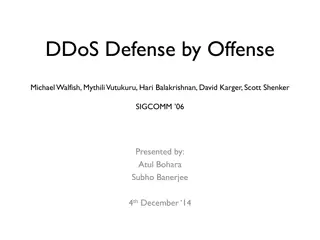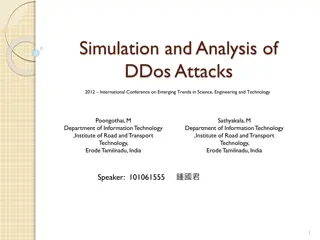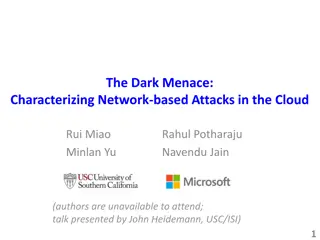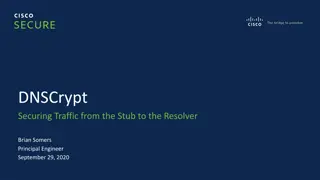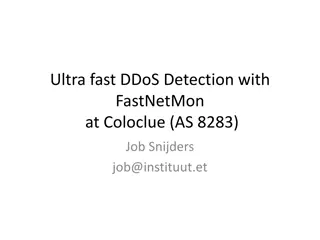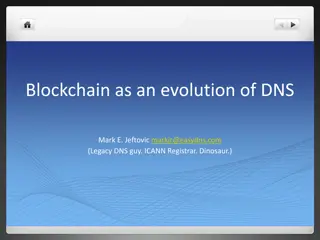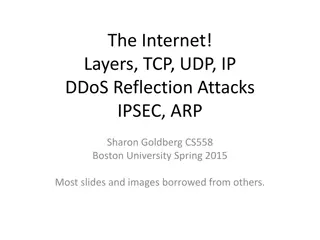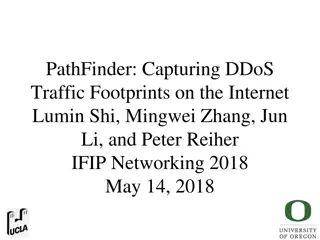
Understanding Dos Attacks and Distributed DoS
Learn about DoS attacks and Distributed Denial of Service (DDoS) attacks, including how attackers overload systems, the use of botnets, and various techniques used in these cyber-attacks. Explore the impact of Smurf attacks, SYN flood attacks, and the TCP handshake protocol in disrupting online services.
Download Presentation

Please find below an Image/Link to download the presentation.
The content on the website is provided AS IS for your information and personal use only. It may not be sold, licensed, or shared on other websites without obtaining consent from the author. If you encounter any issues during the download, it is possible that the publisher has removed the file from their server.
You are allowed to download the files provided on this website for personal or commercial use, subject to the condition that they are used lawfully. All files are the property of their respective owners.
The content on the website is provided AS IS for your information and personal use only. It may not be sold, licensed, or shared on other websites without obtaining consent from the author.
E N D
Presentation Transcript
DoS Attacks By Mohammad Ali and Ahmed El-Shafie
What are DoS Attacks? A type of cyber-attack where an attacker s goal is to make a online service unavailable. Usually done by overloading systems with fake requests Prevents systems from serving legitimate requests. Attackers perform this attack on high-profile servers for revenge, blackmail, activism, etc.
Distributed DoS A serious type of Dos attack where a perpetrator uses thousands of unique IP addresses to flood or crash a service running on a host. The incoming traffic originates from different sources making the attack hard to stop. It is also difficult to distinguish between traffic from legitimate users and attackers.
Botnets and Distributed DoS What are botnets? A network of connected computers that can be used to perform tasks that the owner of the network wants. How are they used to carry out Distributed DoS attacks? Amplifies DoS attacks Typically, malware is used to add a computer to the botnet. Grum, 2008-2012, responsible for 18% of spam in 2009.
Techniques of Distributed DoS Smurf Attacks: Large number of ICMP packets sent with a spoofed IP source address to a IP broadcast address. If the network is large enough, the victim will be flooded with response packets. Server will be too busy allocating for and loading incoming spam packets to serve legitimate Users. (Memory and time being wasted)
Techniques of Distributed DoS During a handshake protocol, a client would send the server a SYN packet, server responds with ACK packet, client responds back. SYN flood: Attacker sends SYN requests to a victim s system in an attempt to make the system unresponsive. Consumes system resources with half-open connections. Using up ports and memory allocated to expected ACK.
TCP Handshake Protocol Host A sends a TCP SYNchronize packet to Host B Host B receives A's SYN Host B sends a SYNchronize-ACKnowledgement Host A receives B's SYN-ACK Host A sends ACKnowledge Host B receives ACK. TCP socket connection is ESTABLISHED SYN flood takes advantage of this by sending SYN packets with no further reply.
Ping of Death Uses the ping command which test for the availability of a service or network resource Sends small data packets to the network resource and waits for response. Attackers can send ICMP ping packets as fast as possible expecting a response back which can consume the target system s resources.
Ping of Death cont. Attackers usually fragment a packet into 65500 bytes which is the maximum size of a packet. When the target system puts the packet together, it may cause a buffer overflow and make the attacker execute malicious code or crash the system. Can also be used to flood the network resource with traffic. Nemesy ping localhost -t -l 65500
Teardrop Attacker sends large data packets TCP/IP breaks packets into smaller fragments Attacker manipulates data fragments as they are sent to overlap with each other. This is done by changing the fragment offset field in a packet. Causes old vulnerable systems to crash.
DNS Flood and Amplification DNS Amplification: Similar to Smurf Attack. Attacker spoofs with target IP and sends DNS request packets that look no different from real requests. DNS servers send back larger responses to target IP, crashing the target.
DNS Flood and Amplification DNS Flood: Attacker attempts to crash the DNS server with thousands of symmetrical requests. Often done using botnets. Since we are not doing a smurf-like attack here the spoofed IP addresses do not need to be real.
Low and Slow attacks Low and Slow attacks are a type of DoS attack that relies upon sending a small stream of traffic for a long period of time. Hogging ports Very hard to distinguish from legitimate traffic. Slowloris and R-u-d-y use this technique to flood a web server.
APDoS Advanced Persistent DoS attacks involve several attack vectors used to take a system down. Usually involves HTTP layer floods followed by SQLi and XSS attacks Also accompanied by SYN floods to generate enormous amounts of traffic. Attackers usually use Botnets to generate such traffic. Switch between attacks to evade detection.
ReDoS Regular Expression DoS attacks exploit Web apps that use regex implemented using NFA. A naive regex algorithm would try all possible paths until a match is found. Catastrophic Backtracking For example, (a+)+ is an Evil regex since its NFA has a lot of possible paths. Causes system to hang if large evil regex is inputted.
ReDoS cont. Evil regexes typically contain repetition (+, *) and grouping. If attacker has control over regex, he can create his own evil regex and use it. If not, the attacker can search the system and find and exploit already existing evil regexes.
Famous DoS Attack - GitHub 5:21-5:26pm Feb 28, 2018 Peak at 1.35 Tbps, 126.9 million packets per second Memcached Attack Attackers spoofed GitHub IP address and made requests to public and vulnerable Memcached server on UDP
General DoS Prevention Increase load tolerance of server Increase bandwidth Increase load management efficiency Block unnecessary and/or malicious IP addresses Use software that has built-in Anti-DDoS tools Snort software has a file ddos.rules that can detect various types of DoS.
ReDoS Prevention Use safe Regex libraries. Timeout if regex evaluation takes too long Avoid evil regex that contain the following: 1. Grouping with repetition 2. Inside the repeated group: Repetition Alternation with overlapping
Links ReDoS: https://www.owasp.org/index.php/Regular_expression_Denial_of_Service_- _ReDoS GitHub DDoS: https://githubengineering.com/ddos-incident-report/ Memcached Attack in more detail: https://www.cloudflare.com/learning/ddos/memcached-ddos-attack/ ReDos Prevention in more detail: https://www.regular-expressions.info/redos.html







